-
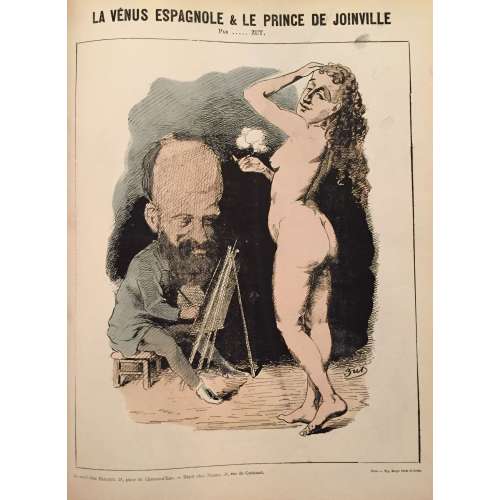 La vénus espagnole et le prince de Joinville par Zut [The Spanish Venus and the Prince of Joinville, by Zut]. Empress Eugénie poses naked for the Prince de Joinville holding a cigarette in her hand. He stares at her intently from his easel.
La vénus espagnole et le prince de Joinville par Zut [The Spanish Venus and the Prince of Joinville, by Zut]. Empress Eugénie poses naked for the Prince de Joinville holding a cigarette in her hand. He stares at her intently from his easel. -
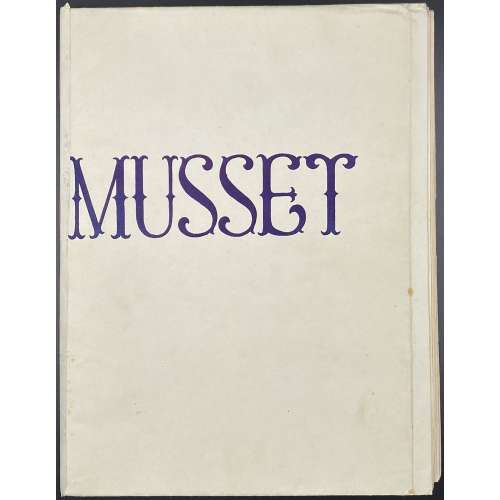 Description: one volume in French flapped wrappers 25.3 x 19 cm, lettered “MUSSET” to front, 5 gatherings of 4 and one of 6 leaves, 26 leaves total, pp.: [4] [2] 3-43 [44] [4], total 52 pages, incl. those in wrappers, unbound; plus coloured and uncoloured suites of 12 lithographs, in a paper folder; in a cardboard tan slipcase 2.8 x 19.3 cm. Artist unknown, publisher unknown, published at the end of 1940s (per J.-P. Dutel). Illustrations are a loose interpretation of original lithographs by Devéria and Henri Grévedon or Octave Tassaert for the 1833 edition ((1926 re-print LIB-3135.2023). Limitation: Edition limited to 250 copies printed on Vélin Chiffon numbered 1 -250 and 24 copies marked by letters A to Z. This is copy № 246, with two suites of plates, one coloured and one b/w. Catalogue raisonné: Dutel (1920-1970) № 1657, p. 189. Alfred de Musset (French, 1810 – 1857) – author.
Description: one volume in French flapped wrappers 25.3 x 19 cm, lettered “MUSSET” to front, 5 gatherings of 4 and one of 6 leaves, 26 leaves total, pp.: [4] [2] 3-43 [44] [4], total 52 pages, incl. those in wrappers, unbound; plus coloured and uncoloured suites of 12 lithographs, in a paper folder; in a cardboard tan slipcase 2.8 x 19.3 cm. Artist unknown, publisher unknown, published at the end of 1940s (per J.-P. Dutel). Illustrations are a loose interpretation of original lithographs by Devéria and Henri Grévedon or Octave Tassaert for the 1833 edition ((1926 re-print LIB-3135.2023). Limitation: Edition limited to 250 copies printed on Vélin Chiffon numbered 1 -250 and 24 copies marked by letters A to Z. This is copy № 246, with two suites of plates, one coloured and one b/w. Catalogue raisonné: Dutel (1920-1970) № 1657, p. 189. Alfred de Musset (French, 1810 – 1857) – author. -
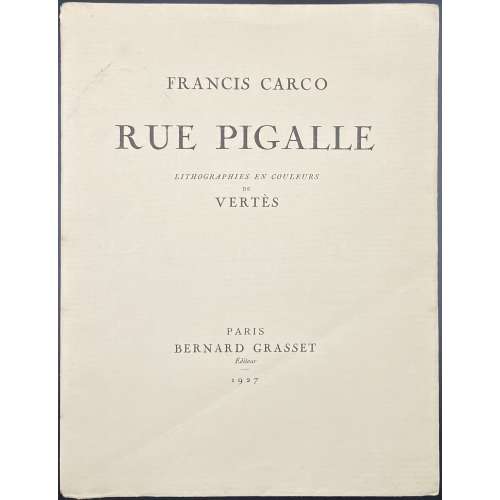 Title-page: FRANCIS CARCO | RUE PIGALLE | LITHOGRAPHIES EN COULEURS | DE | VERTÈS | PARIS | BERNARD GRASSET | Éditeur | 1927 || Description: 25.7 x 19.5 cm, French flapped cream wrappers with black lettering similar to title, lettering to spine, [2] 1st blank leaf, [2] h.t. / blank, plate / blank, [2] t.p. /blank, dedication “A | FRED ANTOINE ANGERMAYER” / blank, [1-2] d.t.p. “CHAPITRE | PREMIER” / blank, [3] 4-124, [2] limitation / blank, [2] last blank leaf; collation: 4to; π4 1-164; total 68 leaves and 14 plates printed by Frères Mourlot after watercolours by Marcel Vertès. Printing : September 15, 1927 by Coulouma in Argenteuil (H. Barthélemy, director); plates printed by Frères Mourlot in Paris; Edition: print run limited to 338 copies of which 22 on Japon Impérial (numbered Japon 1-15 and I-VII) enriched with one original watercolour drawing, one suite in black and one in colour, etc.; 43 copies on Hollande van Gelder (Hollande 1-33 and I-X) with additional suites in black and in colour; 270 copies on Vélin d’Arches (Arches 1-250 and I-XX); and 3 “special” copies. This copy is numbered Arches № 162. Contributors: Francis Carco [François Carcopino-Tusoli] (French, 1886 – 1958) – author. Marcel Vertès [Marcell Vértes] (Jewish-Hungarian-French, 1895 – 1961) – artist. Frères Mourlot – lithographer. Robert Coulouma (French, 1887 – 1976) – printer. Bernard Grasset (French, 1881 – 1955) – publisher. Fred Antoine Angermayer (German, 1889 –1951) – dedicatee. Other names: Marcel Vertès, Marcel Vertes, Marcell Vértes
Title-page: FRANCIS CARCO | RUE PIGALLE | LITHOGRAPHIES EN COULEURS | DE | VERTÈS | PARIS | BERNARD GRASSET | Éditeur | 1927 || Description: 25.7 x 19.5 cm, French flapped cream wrappers with black lettering similar to title, lettering to spine, [2] 1st blank leaf, [2] h.t. / blank, plate / blank, [2] t.p. /blank, dedication “A | FRED ANTOINE ANGERMAYER” / blank, [1-2] d.t.p. “CHAPITRE | PREMIER” / blank, [3] 4-124, [2] limitation / blank, [2] last blank leaf; collation: 4to; π4 1-164; total 68 leaves and 14 plates printed by Frères Mourlot after watercolours by Marcel Vertès. Printing : September 15, 1927 by Coulouma in Argenteuil (H. Barthélemy, director); plates printed by Frères Mourlot in Paris; Edition: print run limited to 338 copies of which 22 on Japon Impérial (numbered Japon 1-15 and I-VII) enriched with one original watercolour drawing, one suite in black and one in colour, etc.; 43 copies on Hollande van Gelder (Hollande 1-33 and I-X) with additional suites in black and in colour; 270 copies on Vélin d’Arches (Arches 1-250 and I-XX); and 3 “special” copies. This copy is numbered Arches № 162. Contributors: Francis Carco [François Carcopino-Tusoli] (French, 1886 – 1958) – author. Marcel Vertès [Marcell Vértes] (Jewish-Hungarian-French, 1895 – 1961) – artist. Frères Mourlot – lithographer. Robert Coulouma (French, 1887 – 1976) – printer. Bernard Grasset (French, 1881 – 1955) – publisher. Fred Antoine Angermayer (German, 1889 –1951) – dedicatee. Other names: Marcel Vertès, Marcel Vertes, Marcell Vértes -
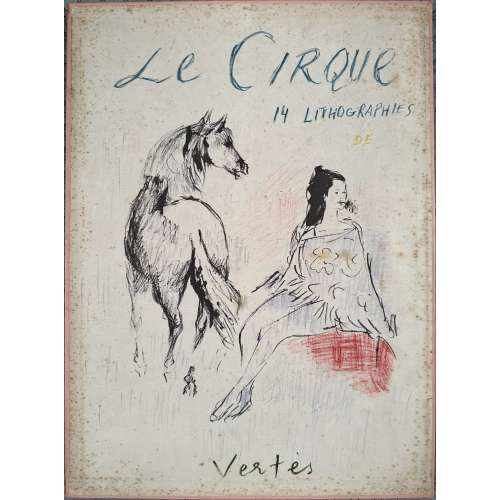 Publisher’s peach cloth box 555 x 410 mm with coloured lithograph on the lid, autographed with crayons "Le Cirque | 14 LITHOGRAPHIES | DE | {vignette} | Vertes"; in-folio unbound 4 pp. booklet on laid paper watermarked “Marais” and 14 loose leaves of plates on laid paper 520 x 395 mm without a watermark with coloured lithographs signed “Vertes” and numbered “195/250” in pencil; interleaved with tracing paper. Box and plates foxed. Title-page (red and black): LE | CIRQUE | 14 LITHOGRAPHIES DE | VERTÈS | PRÉSENTÉ | PAR | JEAN COCTEAU || Imprint: LES LIVES MERVEILLEUX | MONACO | Il a été tiré de cet album : | 150 Exemplaires, | destinés à | l'Amérique, | distribués bar les soins de | Arthur H. Harlow | de New-York, | & | 100 Exemplaires, | réservés à la France. | 15 Avril 1949 || Limitation: Edition limited to 250 copies (150 for USA, 100 for France); this is copy № 195 printed for France as the American copies marked “Published by Arthur H. Harlow & Co., New York. Seller’s Description: VERTÈS, Marcel (Hungarian-French, 1895-1961). Le Cirque 14 Lithographies de Vertès. Présénte par Jean Cocteau. [Monaco: Les Livres Merveilleux, 1949]. [vi] pp. With all 14 lithographs, each signed by the artist and numbered “195/250”. Text and lithographs 15 ¼ x 20 ½”. In original publisher’s peach cloth box with printed label on lid (box foxed, soiled, lightly worn; lithographs and text foxed). Still, a very good example of this lovely collection, with an introduction by Jean Cocteau (1889-1963). Catalogue Raisonné: Vokaer № 50. Marcel Vertès [Marcell Vértes] (Jewish-Hungarian-French, 1895 – 1961) – artist. Arthur H. Harlow (American, c. 1877 – 1958) – publisher. Jean Cocteau (French, 1889 – 1963) – author.
Publisher’s peach cloth box 555 x 410 mm with coloured lithograph on the lid, autographed with crayons "Le Cirque | 14 LITHOGRAPHIES | DE | {vignette} | Vertes"; in-folio unbound 4 pp. booklet on laid paper watermarked “Marais” and 14 loose leaves of plates on laid paper 520 x 395 mm without a watermark with coloured lithographs signed “Vertes” and numbered “195/250” in pencil; interleaved with tracing paper. Box and plates foxed. Title-page (red and black): LE | CIRQUE | 14 LITHOGRAPHIES DE | VERTÈS | PRÉSENTÉ | PAR | JEAN COCTEAU || Imprint: LES LIVES MERVEILLEUX | MONACO | Il a été tiré de cet album : | 150 Exemplaires, | destinés à | l'Amérique, | distribués bar les soins de | Arthur H. Harlow | de New-York, | & | 100 Exemplaires, | réservés à la France. | 15 Avril 1949 || Limitation: Edition limited to 250 copies (150 for USA, 100 for France); this is copy № 195 printed for France as the American copies marked “Published by Arthur H. Harlow & Co., New York. Seller’s Description: VERTÈS, Marcel (Hungarian-French, 1895-1961). Le Cirque 14 Lithographies de Vertès. Présénte par Jean Cocteau. [Monaco: Les Livres Merveilleux, 1949]. [vi] pp. With all 14 lithographs, each signed by the artist and numbered “195/250”. Text and lithographs 15 ¼ x 20 ½”. In original publisher’s peach cloth box with printed label on lid (box foxed, soiled, lightly worn; lithographs and text foxed). Still, a very good example of this lovely collection, with an introduction by Jean Cocteau (1889-1963). Catalogue Raisonné: Vokaer № 50. Marcel Vertès [Marcell Vértes] (Jewish-Hungarian-French, 1895 – 1961) – artist. Arthur H. Harlow (American, c. 1877 – 1958) – publisher. Jean Cocteau (French, 1889 – 1963) – author. -

Lithography on paper by Charles Fichot (French, 1817 – 1903), published in a supplement to the Illustrated London News of July 6, 1867.
The construction on the foreground is the International Exposition of 1867 (Exposition universelle d'art et d'industrie de 1867). Dimensions: Sheet: 130 x 58 cm; Image: 118 x 43 cm. -
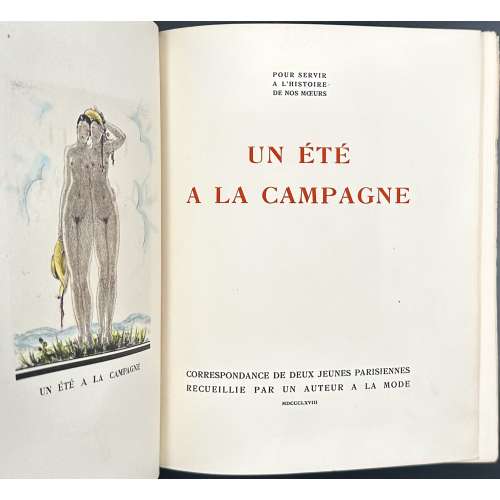 Softcover, 228 x 180 mm, tan French flapped wrappers with red lettering to front[1-4, owner’s glassine dustcover, top edge trimmed, printed on thick wove paper without a watermark; pp.: ffl [1-4 h.t., t.p.] 5-154 [2 blanks] colophon to back ffl recto, plus 12 plates with hand-coloured lithographs, extraneous to collation. Pencil and pigment drawing to h.t. signed “J. D’A” with gift manual inscription “A Monsieur et Madame Chalamel [sic] ce tardif mais sincère souvenir de sympathie”, signed “J et Y D’A.” Etching bookplate to front ffl recto: “EX LIBRIS PIERRE CHALLAMEL | JE FONCE DANS LE BROUILLARD”, signed “J A M” (Jean-Adrien Mercier). The signature J. D’A stands for Jean d’Angers, while Y D’A stands for Jean-Adrien’s wife Yvonne (1902—1999), nicknamed Zizi; they married in 1927. According to J.-P. Dutel, the stated illustrator of this edition, Jean d’Angers is indeed Jean-Adrien Mercier. The text belongs to Gustav Droz and, possibly, Auguste Poulet-Malassis. Limitation: the book was printed for subscribers in 30 copies on Japon Impériale paper (№№ 1-30) and 250 copies on vélin du Marais paper (№№ 31-280). This copy bears № 123 and was presented as a gift by the artist and his wife to Pierre Challamel. Title-page (red and black): POUR SERVIR | A L'HISTOIRE | DE NOS MŒURS | UN ÉTÉ | A LA CAMPAGNE | CORRESPONDANCE DE DEUX JEUNES PARISIENNES | RECUEILLIE PAR UN AUTEUR A LA MODE | MDCCCLXVIII || Catalogue raisonné: Dutel III № 2546; honesterotica. Provenance: Pierre Challamel (French, 20th century) Contributors: Gustave Droz (French, 1832 – 1895) – author (presumable). Auguste Poulet-Malassis (French, 1825 – 1878) – author (presumable). Jean-Adrien Mercier (French, 1899 – 1995) – artist. Micro photo of the lithography:
Softcover, 228 x 180 mm, tan French flapped wrappers with red lettering to front[1-4, owner’s glassine dustcover, top edge trimmed, printed on thick wove paper without a watermark; pp.: ffl [1-4 h.t., t.p.] 5-154 [2 blanks] colophon to back ffl recto, plus 12 plates with hand-coloured lithographs, extraneous to collation. Pencil and pigment drawing to h.t. signed “J. D’A” with gift manual inscription “A Monsieur et Madame Chalamel [sic] ce tardif mais sincère souvenir de sympathie”, signed “J et Y D’A.” Etching bookplate to front ffl recto: “EX LIBRIS PIERRE CHALLAMEL | JE FONCE DANS LE BROUILLARD”, signed “J A M” (Jean-Adrien Mercier). The signature J. D’A stands for Jean d’Angers, while Y D’A stands for Jean-Adrien’s wife Yvonne (1902—1999), nicknamed Zizi; they married in 1927. According to J.-P. Dutel, the stated illustrator of this edition, Jean d’Angers is indeed Jean-Adrien Mercier. The text belongs to Gustav Droz and, possibly, Auguste Poulet-Malassis. Limitation: the book was printed for subscribers in 30 copies on Japon Impériale paper (№№ 1-30) and 250 copies on vélin du Marais paper (№№ 31-280). This copy bears № 123 and was presented as a gift by the artist and his wife to Pierre Challamel. Title-page (red and black): POUR SERVIR | A L'HISTOIRE | DE NOS MŒURS | UN ÉTÉ | A LA CAMPAGNE | CORRESPONDANCE DE DEUX JEUNES PARISIENNES | RECUEILLIE PAR UN AUTEUR A LA MODE | MDCCCLXVIII || Catalogue raisonné: Dutel III № 2546; honesterotica. Provenance: Pierre Challamel (French, 20th century) Contributors: Gustave Droz (French, 1832 – 1895) – author (presumable). Auguste Poulet-Malassis (French, 1825 – 1878) – author (presumable). Jean-Adrien Mercier (French, 1899 – 1995) – artist. Micro photo of the lithography:
Micro photo of the original drawing: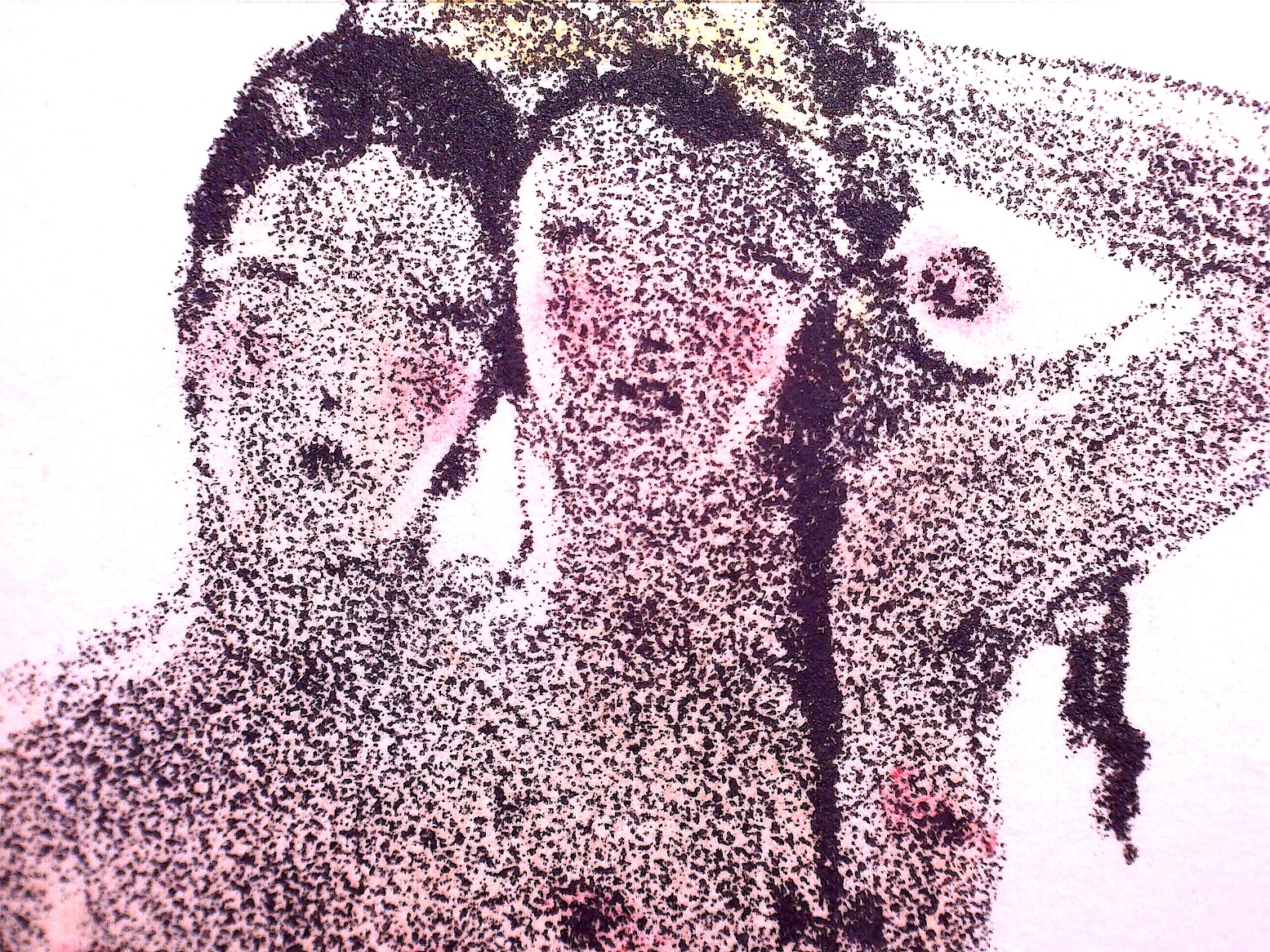
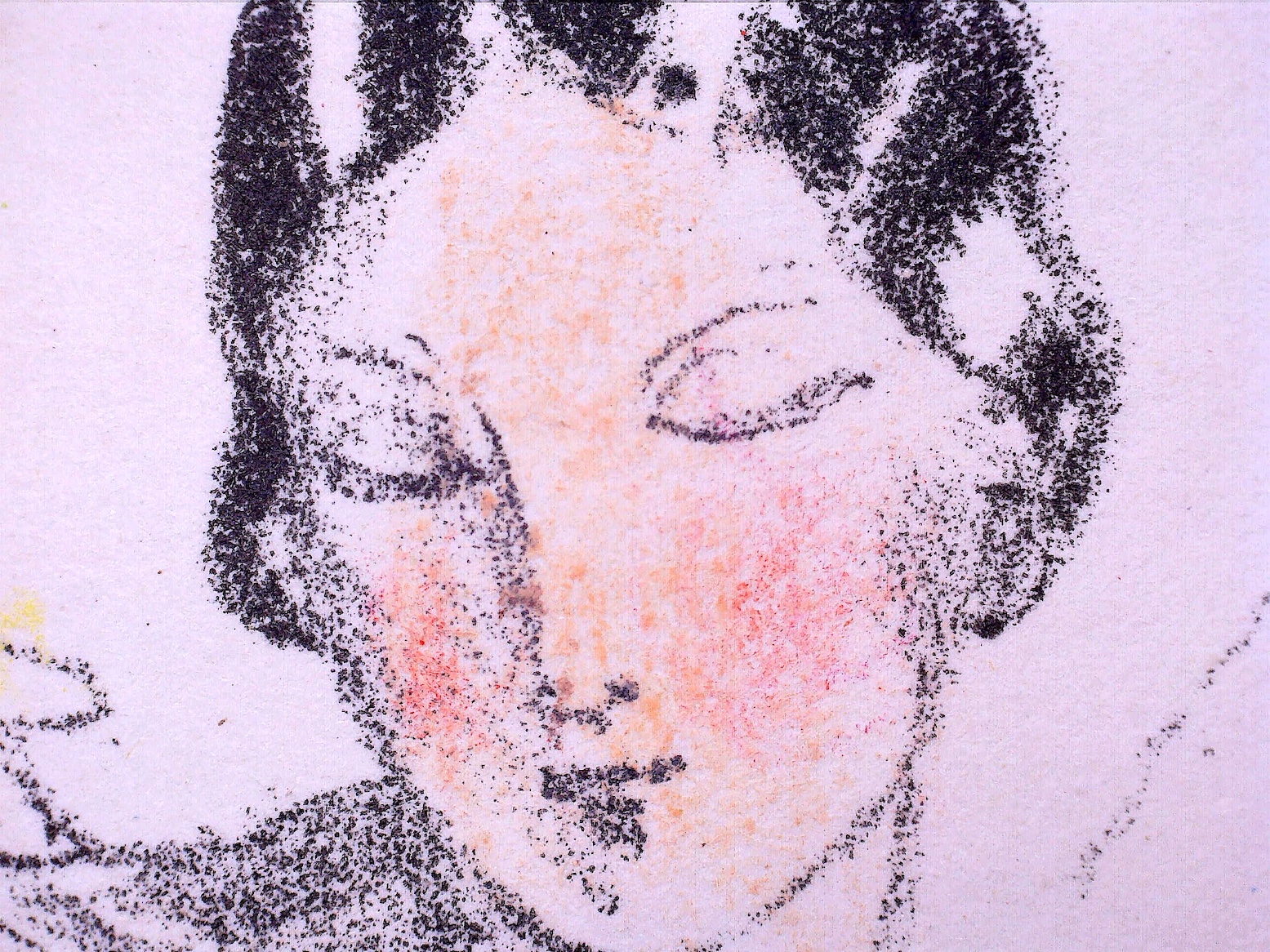
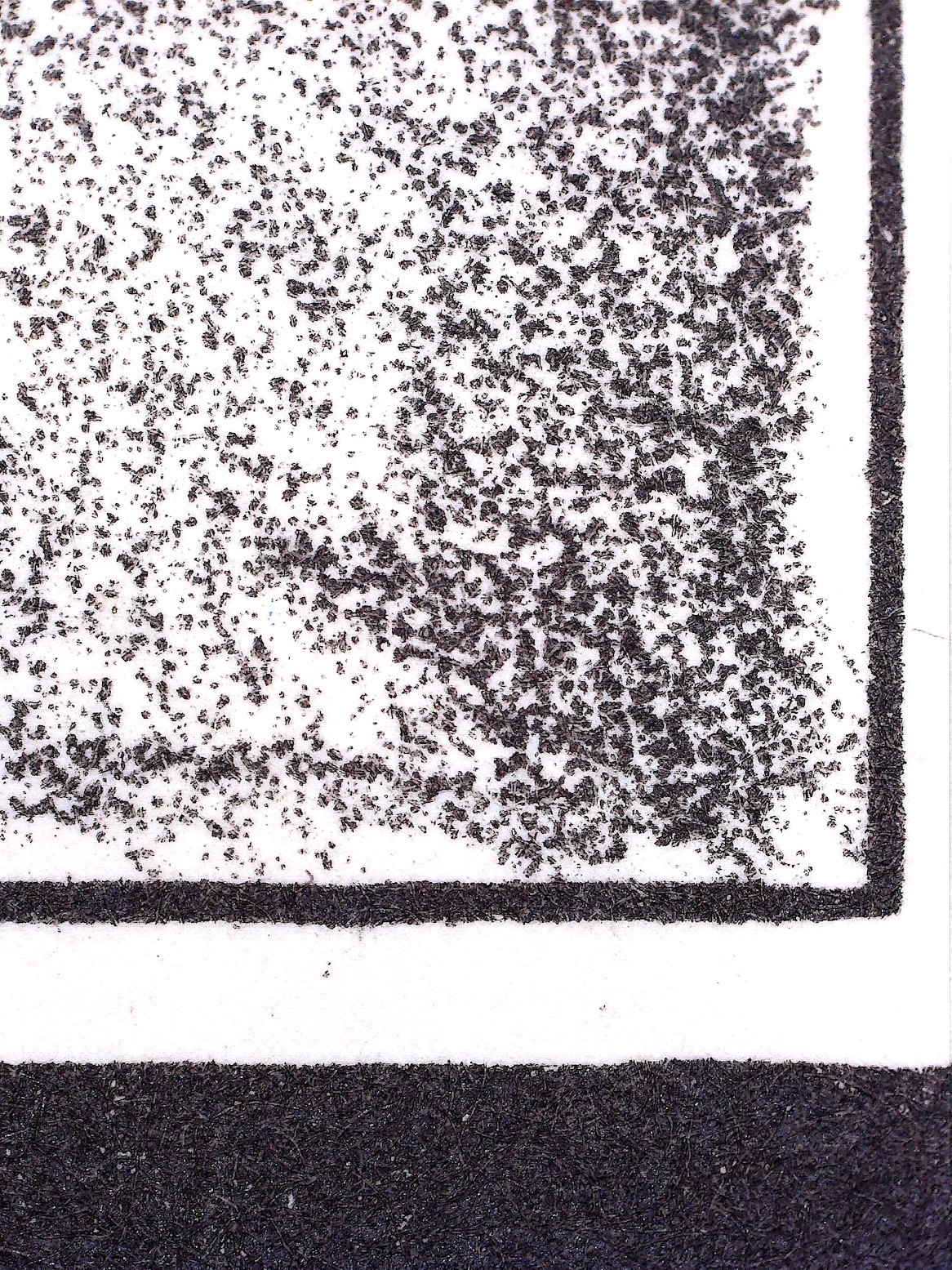
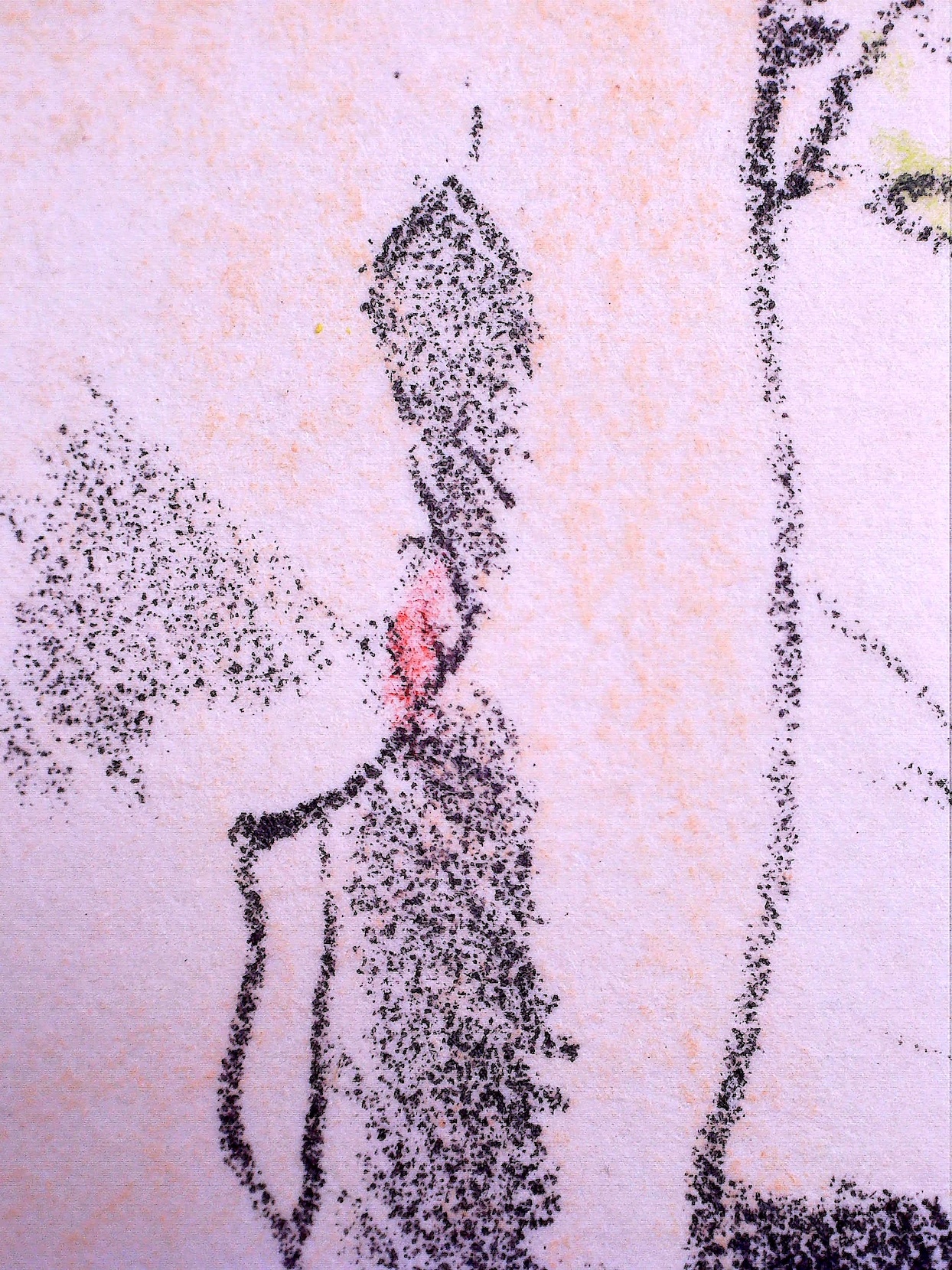
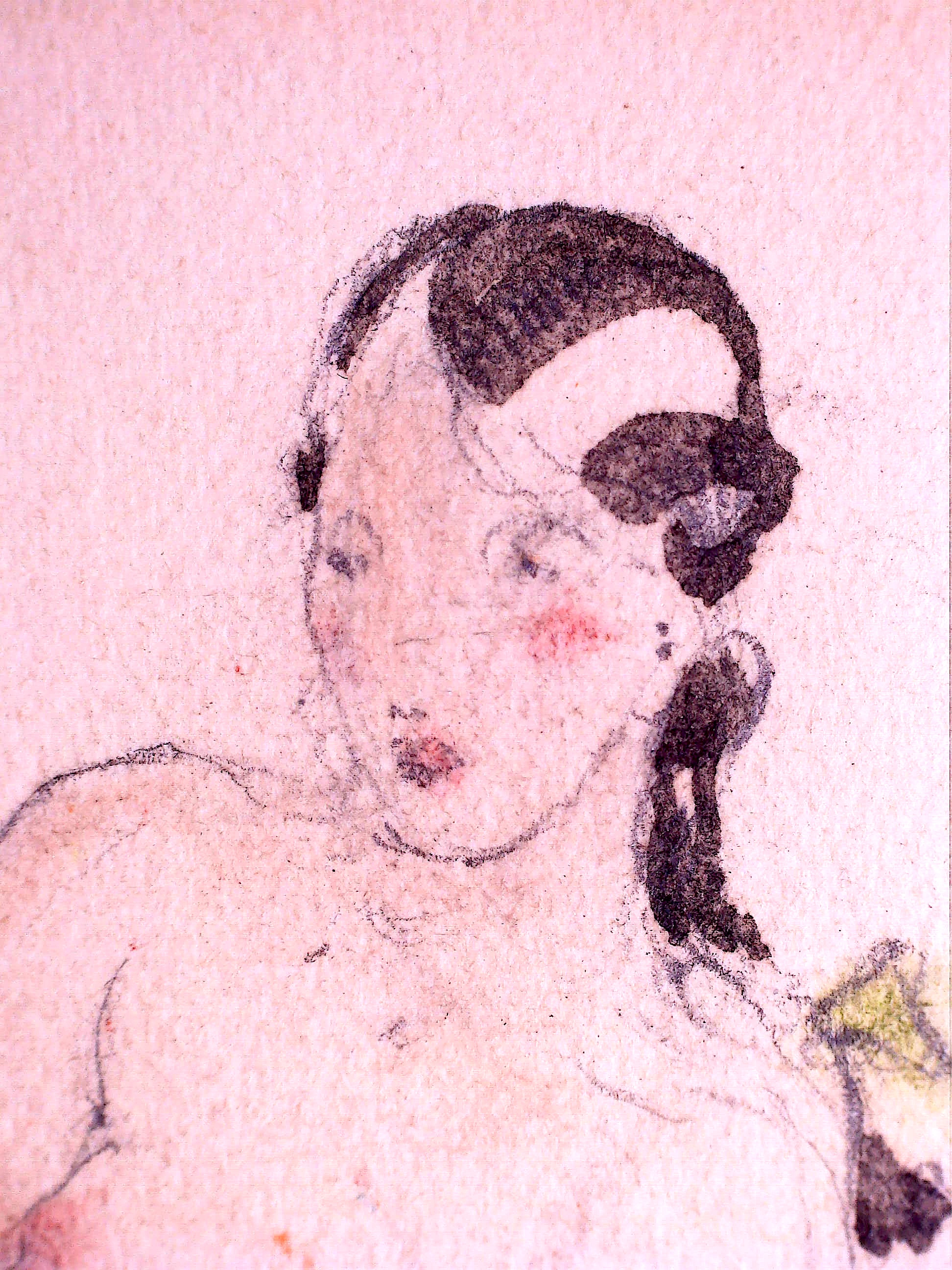
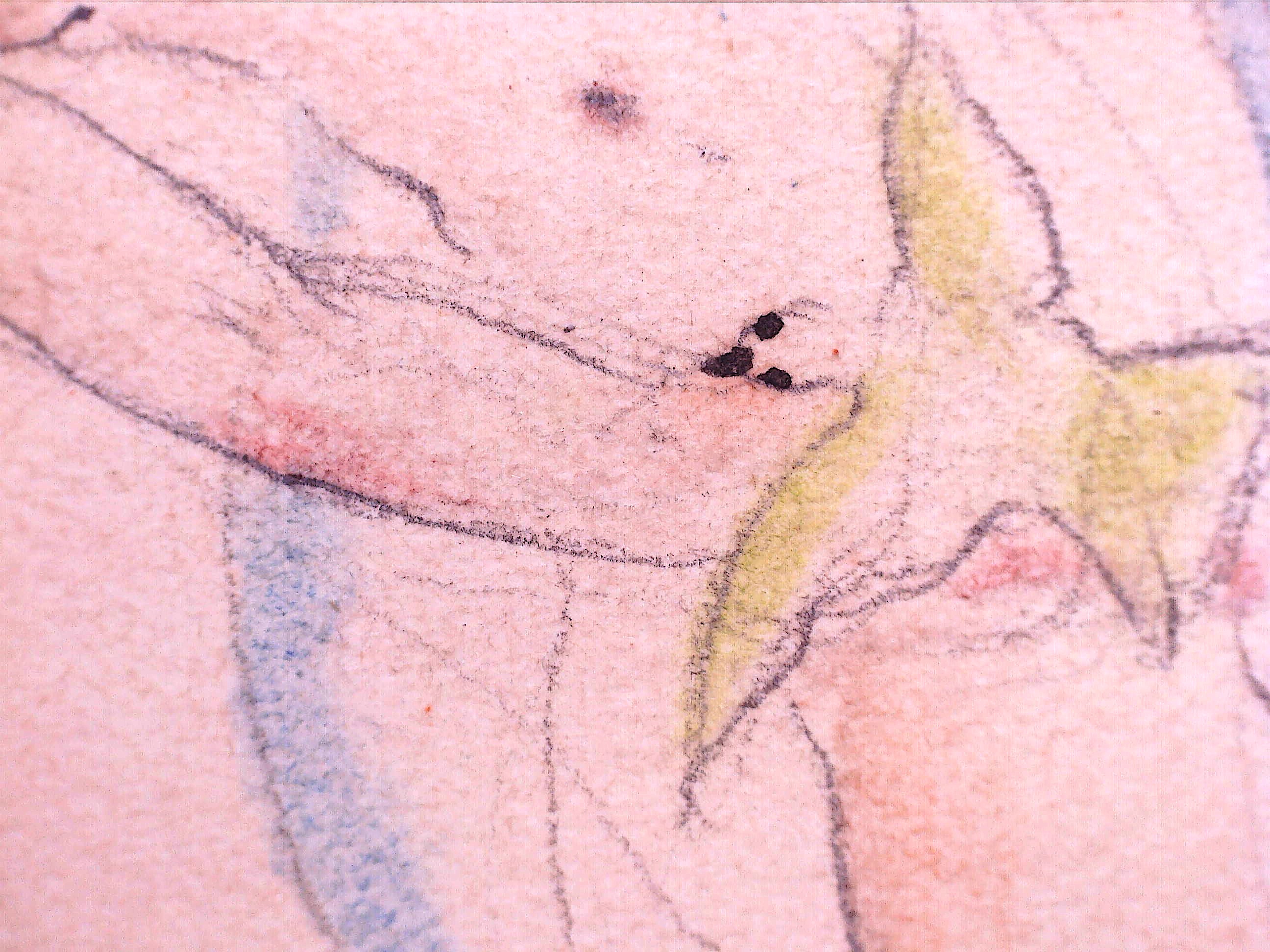
-
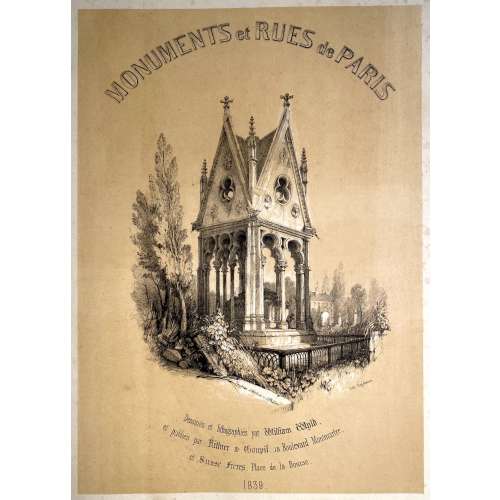 Pictorial album 55.5 x 41.0 cm, publisher’s quarter sheepskin over cloth, upper cover and flat spine lettered in gilt. Title: MONUMENTS et RUES de PARIS | Dessinés et lithographiés par William Wyld, | et publiés par Rittner & Goupil, 15 Boulevard Montmartre, | et Susse Frères, Place de la Bourse. | 1839. Collation: Title plate + 20 plates numbered from 1 to 20, printed by Godefroy Engelmann (French, 1788 – 1839) in tone lithography after drawings by William Wyld (British, 1806 – 1889). Published in Paris by Rittner & Goupil and Susse Frères in 1839. Plates: 54.8 x 39.8 cm. Contents:
Pictorial album 55.5 x 41.0 cm, publisher’s quarter sheepskin over cloth, upper cover and flat spine lettered in gilt. Title: MONUMENTS et RUES de PARIS | Dessinés et lithographiés par William Wyld, | et publiés par Rittner & Goupil, 15 Boulevard Montmartre, | et Susse Frères, Place de la Bourse. | 1839. Collation: Title plate + 20 plates numbered from 1 to 20, printed by Godefroy Engelmann (French, 1788 – 1839) in tone lithography after drawings by William Wyld (British, 1806 – 1889). Published in Paris by Rittner & Goupil and Susse Frères in 1839. Plates: 54.8 x 39.8 cm. Contents:Title page: Tombeau d'Heloïse et d'Abélard
- Le Pont Neuf
- L'église de la Madeleine
- La Porte St. Martin
- Palais des Tuileries
- Pont des Saints-Pères
- Hôtel de Ville
- Marché des Innocents
- Palais Royal
- Boulevard des Italiens
- Rue de la Paix
- Bourse et Tribunal de Commerce
- Porte St. Denis
- Pont Royal
- Place de la Concorde
- Paris from Père Lachaise
- Notre-Dame
- Jardin des Tuileries with Arc de Triomphe in the Distance
- Panthéon
- Chambre des députés
- Arc de Triomphe de l'Étoile
-
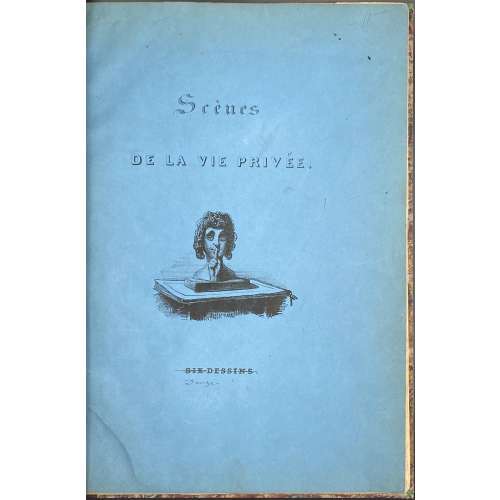 Pictorial album 31 x 22.8 cm, bound in quarter red calf over marbled boards with gilt lettering “SCÈNES | DE | LA VIE | PRIVÉE” and gilt ornament to spine; marbled endpapers, flyleaf, blue original wrapper (title-page) lettered SCÈNES | DE LA VIE PRIVÉE. | {vignette} | SIX DESSINS || «Six dessins» struck out, ms inscription beneath “Douze”. Twelve hand-coloured lithographs, some inscribed with letters and/or numbers in reverse, each in a double-rule frame 22 x 16.5 cm, images 18 x 14.5 cm (approx.); series title “Scènes de la vie intime” printed above the frame, image title printed in the lower compartment; ms numbers above the upper-right corner of the frame (state before sequential numbers, ms numbers do not correspond with artist numbering). Flyleaf at the end. Two bookplates to front pastedown: “EX-LIBRIS PAUL GAVAULT” and armorial “IN ROBORE ROBUR | Ex Libris Bourlon de Rouvre”. Content (Roman numerals in parenthesis are publisher's numbers; numerals in italic are Armelhault-Bocher reference numbers):
Pictorial album 31 x 22.8 cm, bound in quarter red calf over marbled boards with gilt lettering “SCÈNES | DE | LA VIE | PRIVÉE” and gilt ornament to spine; marbled endpapers, flyleaf, blue original wrapper (title-page) lettered SCÈNES | DE LA VIE PRIVÉE. | {vignette} | SIX DESSINS || «Six dessins» struck out, ms inscription beneath “Douze”. Twelve hand-coloured lithographs, some inscribed with letters and/or numbers in reverse, each in a double-rule frame 22 x 16.5 cm, images 18 x 14.5 cm (approx.); series title “Scènes de la vie intime” printed above the frame, image title printed in the lower compartment; ms numbers above the upper-right corner of the frame (state before sequential numbers, ms numbers do not correspond with artist numbering). Flyleaf at the end. Two bookplates to front pastedown: “EX-LIBRIS PAUL GAVAULT” and armorial “IN ROBORE ROBUR | Ex Libris Bourlon de Rouvre”. Content (Roman numerals in parenthesis are publisher's numbers; numerals in italic are Armelhault-Bocher reference numbers):- Titre de la couverture (Title-page) – 2001
- (III) Un nid dans les blés (A nest in the wheat) – 2004
- (II) Amitié de pension (Friendship in the pension) – 2003
- (XI) Bras dessus, bras dessous (Arm up, arm down) – 2012
- (I) Causerie (Chat) – 2002
- (VI) Prélude (Prelude) – 2007
- (IX) Le guet-apens (Ambush) – 2010
- (V) Le cabinet noir (The dark chamber) – 2006
- (IV) Distraction (Entertainment) – 2005
- (X) Leçon de paysage (Landscape lesson) – 2011
- (VII) Avant le péché (Before sin) – 2008
- (VIII) Après le péché (After sin) – 2009
- (XII) La femme du peintre (The painter's wife) – 2013
-
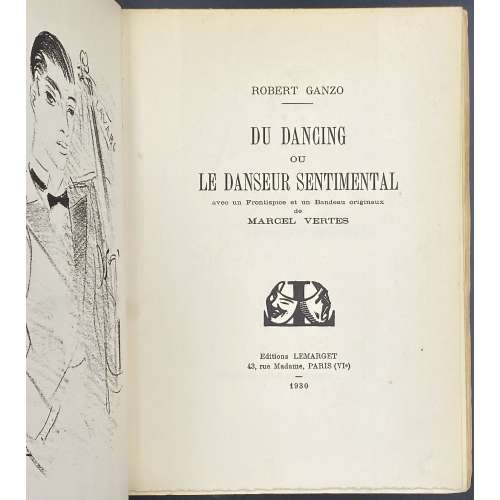 Title-page: ROBERT GANZO | DU DANCING | OU | LE DANSEUR SENTIMENTAL | avec un Frontispice et un Bandeau originaux | de | MARCEL VERTES | {publisher’s device} | Editions LEMARGET | 43, rue Madame, PARIS (VIe) | 1930.|| Description: 20.7 x 14.9 cm, French flapped cream wrappers with black and green lettering similar to title, lettering to spine “DU DANCING”; [1-13] incl. leaf in wrapper, 1st blank leaf, h.t. / limitation, frontispiece, t.p. / copyright, dedication to Gaston Guillot / blank, 14-106 [4] colophon / blank, and one leaf in wrapper; frontispiece and first chapter headpiece lithography by Vertès, plus inset of the same. Collation: 4to; [1,2]4 3-134 143; total 55 leaves. Printing: June 10, 1930, by Presses Modernes in Reims. Edition: 15 copies on Japon Impérial numbered I-XV, 20 colies on Hollande Van Gelder numbered XVI-XXXV, 250 copies on Vélin de Rives numbered 1-250, 20 of which reserved for the bookstore of H. Champion, and 25 presentation copies numbered A-Z. This copy is № XVI. Contributors: Robert Ganzo (French, 1898 – 1995) – author. Marcel Vertès [Marcell Vértes] (Jewish-Hungarian-French, 1895 – 1961) – artist. Gaston Guillot (French, 1889 – 1960) – dedicatee. Editions Lemarget (Paris) – publisher. Presses Modernes (Reims) – printer. Other names: Marcel Vertès, Marcel Vertes, Marcell Vértes
Title-page: ROBERT GANZO | DU DANCING | OU | LE DANSEUR SENTIMENTAL | avec un Frontispice et un Bandeau originaux | de | MARCEL VERTES | {publisher’s device} | Editions LEMARGET | 43, rue Madame, PARIS (VIe) | 1930.|| Description: 20.7 x 14.9 cm, French flapped cream wrappers with black and green lettering similar to title, lettering to spine “DU DANCING”; [1-13] incl. leaf in wrapper, 1st blank leaf, h.t. / limitation, frontispiece, t.p. / copyright, dedication to Gaston Guillot / blank, 14-106 [4] colophon / blank, and one leaf in wrapper; frontispiece and first chapter headpiece lithography by Vertès, plus inset of the same. Collation: 4to; [1,2]4 3-134 143; total 55 leaves. Printing: June 10, 1930, by Presses Modernes in Reims. Edition: 15 copies on Japon Impérial numbered I-XV, 20 colies on Hollande Van Gelder numbered XVI-XXXV, 250 copies on Vélin de Rives numbered 1-250, 20 of which reserved for the bookstore of H. Champion, and 25 presentation copies numbered A-Z. This copy is № XVI. Contributors: Robert Ganzo (French, 1898 – 1995) – author. Marcel Vertès [Marcell Vértes] (Jewish-Hungarian-French, 1895 – 1961) – artist. Gaston Guillot (French, 1889 – 1960) – dedicatee. Editions Lemarget (Paris) – publisher. Presses Modernes (Reims) – printer. Other names: Marcel Vertès, Marcel Vertes, Marcell Vértes -
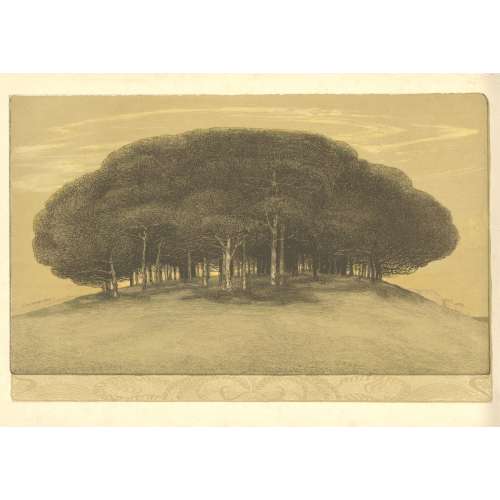 Colour (tone) lithography, image 268 x 410 mm, sheet 317 x 470 mm; signed on bottom-left of the image “Pelikan 1905”, and pencil ms inscription: E. Pelikan to the lower-right corner of the sheet. Contributor: Emilie Mediz-Pelikan (Austrian, 1861 – 1908) – artist. Seller's description: Austrian-German painter and graphic artist. Emilie Mediz-Pelikan was born in Vöcklabruck in 1861. She studied at the Vienna Academy and followed her teacher Albert Zimmermann to Salzburg and in 1885 to Munich. In 1891 she married the painter and graphic artist Karl Mediz (1868 - 1945), with whom she lived in Vienna and from 1894 in Dresden. She was in contact with the Dachau Artists' Colony and went on study trips to Paris, Belgium, Hungary and Italy. In the Dachau artists' colony she was friends with Adolf Hölzel and Fritz von Uhde. In 1889 and 1890 she spent time in Paris and in the Belgian artists' colony Knokke. In 1898 she was represented at the first art exhibition of the Vienna Secession, and in 1901 at the International Art Exhibition in Dresden. In 1903 she and her husband had a group exhibition, at the Hagenbund in Vienna. In 1904, she showed graphic works at the Dresden royal court art dealer Richter, and in 1905 and 1906 she exhibited at the Berlin Künstlerhaus. It was not until around 1900 that she achieved her artistic breakthrough with her landscape paintings. Since the estate of the artist, who died prematurely in Dresden in 1908, was lost in the former GDR until the 1980s, it was quite late that the artist was rediscovered and revalued both in Austrian art history and on the art market. In 1986, the first major exhibitions took place at the Upper Austrian State Museum and the University of Applied Arts in Vienna, followed by numerous smaller exhibitions in private galleries in Vienna, Linz and Munich. The artist received recognition during her lifetime from numerous prominent fellow painters as well as from the art critic Ludwig Hevesi. Together with Tina Blau, Herbert Boeckl, Marie Egner, Theodor von Hörmann, Franz Jaschke, Eugen Jettel, Ludwig Heinrich Jungnickel, Rudolf Junk, Gustav Klimt, Oskar Kokoschka, Johann Victor Krämer, Heinrich Kühn, Carl Moll, Rudolf Quittner, Rudolf Ribarz, Emil Jakob Schindler, Max Suppantschitsch, Max Weiler, Olga Wisinger-Florian and Alfred Zoff, she was a protagonist of the reception of Impressionism in Austria. This style went down in Austrian art history under the term "Stimmungsimpressionismus".
Colour (tone) lithography, image 268 x 410 mm, sheet 317 x 470 mm; signed on bottom-left of the image “Pelikan 1905”, and pencil ms inscription: E. Pelikan to the lower-right corner of the sheet. Contributor: Emilie Mediz-Pelikan (Austrian, 1861 – 1908) – artist. Seller's description: Austrian-German painter and graphic artist. Emilie Mediz-Pelikan was born in Vöcklabruck in 1861. She studied at the Vienna Academy and followed her teacher Albert Zimmermann to Salzburg and in 1885 to Munich. In 1891 she married the painter and graphic artist Karl Mediz (1868 - 1945), with whom she lived in Vienna and from 1894 in Dresden. She was in contact with the Dachau Artists' Colony and went on study trips to Paris, Belgium, Hungary and Italy. In the Dachau artists' colony she was friends with Adolf Hölzel and Fritz von Uhde. In 1889 and 1890 she spent time in Paris and in the Belgian artists' colony Knokke. In 1898 she was represented at the first art exhibition of the Vienna Secession, and in 1901 at the International Art Exhibition in Dresden. In 1903 she and her husband had a group exhibition, at the Hagenbund in Vienna. In 1904, she showed graphic works at the Dresden royal court art dealer Richter, and in 1905 and 1906 she exhibited at the Berlin Künstlerhaus. It was not until around 1900 that she achieved her artistic breakthrough with her landscape paintings. Since the estate of the artist, who died prematurely in Dresden in 1908, was lost in the former GDR until the 1980s, it was quite late that the artist was rediscovered and revalued both in Austrian art history and on the art market. In 1986, the first major exhibitions took place at the Upper Austrian State Museum and the University of Applied Arts in Vienna, followed by numerous smaller exhibitions in private galleries in Vienna, Linz and Munich. The artist received recognition during her lifetime from numerous prominent fellow painters as well as from the art critic Ludwig Hevesi. Together with Tina Blau, Herbert Boeckl, Marie Egner, Theodor von Hörmann, Franz Jaschke, Eugen Jettel, Ludwig Heinrich Jungnickel, Rudolf Junk, Gustav Klimt, Oskar Kokoschka, Johann Victor Krämer, Heinrich Kühn, Carl Moll, Rudolf Quittner, Rudolf Ribarz, Emil Jakob Schindler, Max Suppantschitsch, Max Weiler, Olga Wisinger-Florian and Alfred Zoff, she was a protagonist of the reception of Impressionism in Austria. This style went down in Austrian art history under the term "Stimmungsimpressionismus". -
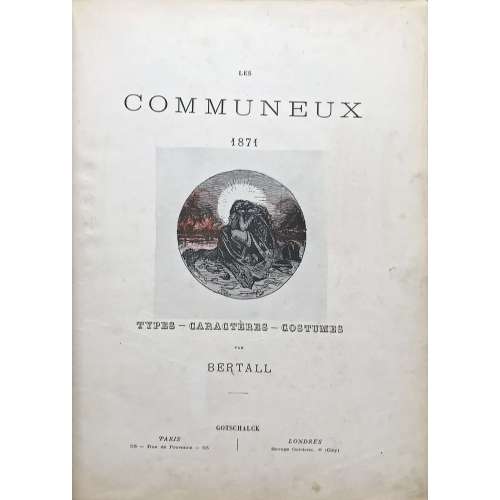 Folio (240 x 320 mm), hardbound in blue-aubergine cloth with gilt lettering and decoration. Album with Avant-Propos and 34 hand-colored lithographs by Bertall, numbered 1 through 34. Details in Russian: "Памяти парижской коммуны".
Folio (240 x 320 mm), hardbound in blue-aubergine cloth with gilt lettering and decoration. Album with Avant-Propos and 34 hand-colored lithographs by Bertall, numbered 1 through 34. Details in Russian: "Памяти парижской коммуны". -
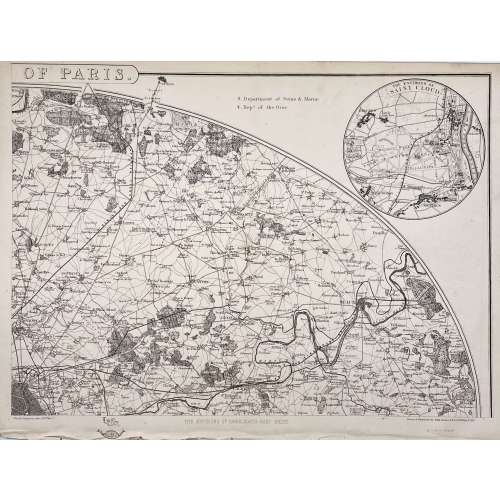 Four maps 34 x 47.5 cm each. Include insets of Versailles, Fontainebleau, Saint Cloud and St. Germain en Laye. Lithograph by Edward Weller after a map drawn and engraved by John Dower. "These maps originally appeared in the Weekly Dispatch newspaper from 1856 to 1862. They were reissued between 1863 and 1867 by Cassell, Petter and Galpin and then published collectively as Cassell's Atlas. The plates were acquired by G.W. Bacon & Co., and reissued in 1876 under the title Bacon's New Quarto Atlas ... of the Counties of England, and many times since under various titles." [WorldCat]
Four maps 34 x 47.5 cm each. Include insets of Versailles, Fontainebleau, Saint Cloud and St. Germain en Laye. Lithograph by Edward Weller after a map drawn and engraved by John Dower. "These maps originally appeared in the Weekly Dispatch newspaper from 1856 to 1862. They were reissued between 1863 and 1867 by Cassell, Petter and Galpin and then published collectively as Cassell's Atlas. The plates were acquired by G.W. Bacon & Co., and reissued in 1876 under the title Bacon's New Quarto Atlas ... of the Counties of England, and many times since under various titles." [WorldCat]Dimensions: 34 x 47.5 cm each.
Contributors: Weller, Edward (British, 1819 – 1884) – lithographer. Dower, John Crane (British, 1791 – 1847) – artist, engraver. Dower, John James (British, 1825 – 1901) – artist, engraver (son of John Crane Dower). -
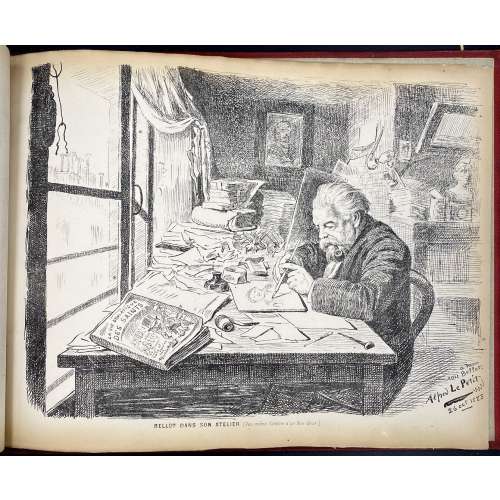 An album of the "Le Bon-Bock" dinners for the year 1884. Author, designer and publisher – Emile Bellot (French, 1831 – 1886), a Parisian artist and engraver. "Le Bon-Bock" was a monthly dinner of artists and men of letters, who gathered in Paris for good food, good company, and artistic performances, from 1875 to at least 1925. The story behind these gatherings as told by Emile Bellot, the founder, is this:
An album of the "Le Bon-Bock" dinners for the year 1884. Author, designer and publisher – Emile Bellot (French, 1831 – 1886), a Parisian artist and engraver. "Le Bon-Bock" was a monthly dinner of artists and men of letters, who gathered in Paris for good food, good company, and artistic performances, from 1875 to at least 1925. The story behind these gatherings as told by Emile Bellot, the founder, is this:In February 1875, Pierre Cottin1 came to me and said: 'I discovered a poet and tragedian of immense talent and who interprets the poems of the Great Victor Hugo in an astonishing way. Monsieur Gambini. I promised him that I would make it heard by an audience of artists and men of letters. I am counting on you who have many connections to keep my promise to him'. I gathered about 25 of my friends and acquaintances in a picnic dinner which took place at a restaurant 'Krauteimer' on the rue Rochechouart in Montmartre. They heard from Mr Gambini first, then my friends Étienne Carjat2, J. Gros3, Adrien Dézamy4, etc. performed. These gentlemen completed the evening so brilliantly that it was unanimously decided that we would start a similar dinner every month. Poets, musicians, men of letters, singers would be invited to this dinner. I was in charge of the organization of this little party and as it was the dream of my life to bring together old comrades, I was careful not to refuse and I pursued this good idea. Cottin and René Tener5 were kind enough to help me in this joyous task and especially my old friend Carjat. The following March began our 1st monthly dinner.
The name "Le Bon-Bock" means "The Good Bock", whilst Bock is a kind of beer, a dark, malty, lightly hopped ale. The dinner was named "Le Bon-Bock" in honour of the Éduard Manet painting (1873), a famous portrait of Emile Bellot, called "Le Bon-Bock".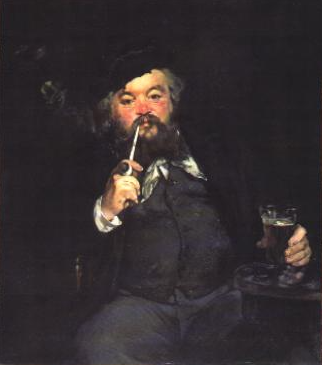 The invitations to the dinner were also produced by the artists and looked like this one by Alexandre Ferdinandus (October 3, 1883).
The invitations to the dinner were also produced by the artists and looked like this one by Alexandre Ferdinandus (October 3, 1883).
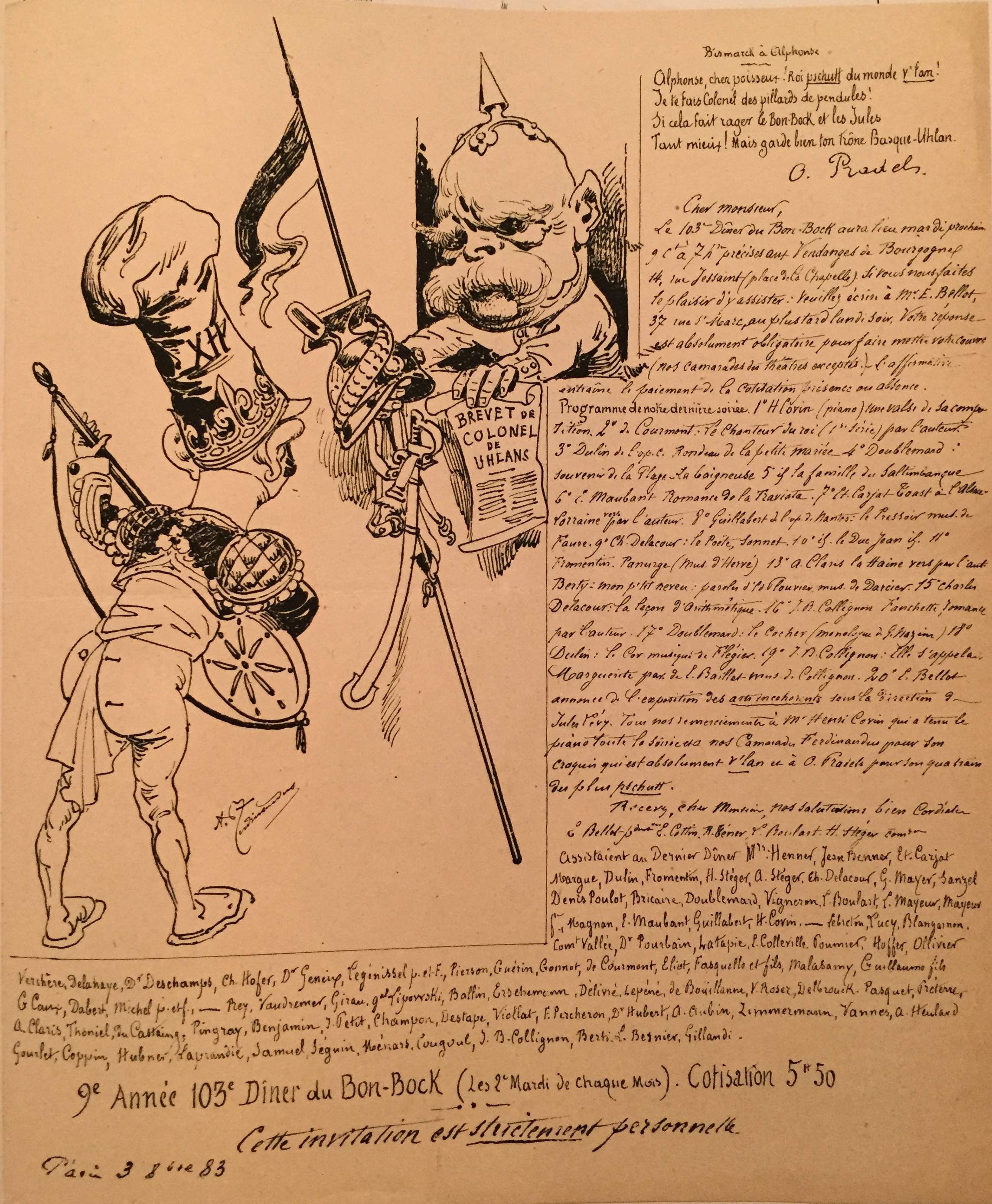 Besides this sketch of the Parisian social and artistic life at the end of the 19th century, the provenance of the album in our collection generates additional interest. The ink stamp to the front flyleaf reads: "Docteur Henry Uzan, 29 Avenue Perrichont, Paris XVI".
Doctor Henry Uzan was Jewish. He was arrested by the Pétain police on October 1, 1941, and interned in Drancy. With the few means at his disposal, he undertook to treat the sick whom he then saw leaving, week after week, towards their terrible destiny in the extermination camps. In October 1943 doctor Uzan was deported to the island of Alderney. After the Normandy Landing of June 6, 1944, Nazis evacuated the island detainees and transfer them to the Neuengamme camp, via northern France and Belgium. During the transfer, doctor Uzan managed to escape from the train on the night of September 3 to 4 around Dixmude in Flanders. He was taken in by the Belgian Resistance, which he joined before being repatriated to France.
In France, he continued working as a physician and was one of the founders of Association des internés et déportés politiques (AIDP). In 1945, together with his friends, the doctor designed the symbol for the Fédération nationale des déportés et internés résistants et patriotes:
Besides this sketch of the Parisian social and artistic life at the end of the 19th century, the provenance of the album in our collection generates additional interest. The ink stamp to the front flyleaf reads: "Docteur Henry Uzan, 29 Avenue Perrichont, Paris XVI".
Doctor Henry Uzan was Jewish. He was arrested by the Pétain police on October 1, 1941, and interned in Drancy. With the few means at his disposal, he undertook to treat the sick whom he then saw leaving, week after week, towards their terrible destiny in the extermination camps. In October 1943 doctor Uzan was deported to the island of Alderney. After the Normandy Landing of June 6, 1944, Nazis evacuated the island detainees and transfer them to the Neuengamme camp, via northern France and Belgium. During the transfer, doctor Uzan managed to escape from the train on the night of September 3 to 4 around Dixmude in Flanders. He was taken in by the Belgian Resistance, which he joined before being repatriated to France.
In France, he continued working as a physician and was one of the founders of Association des internés et déportés politiques (AIDP). In 1945, together with his friends, the doctor designed the symbol for the Fédération nationale des déportés et internés résistants et patriotes:
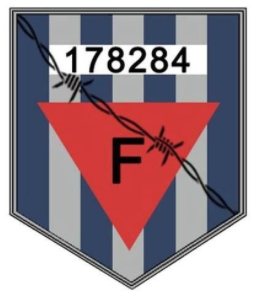 The story behind the number on the emblem (178284) is fascinating but it is out of the scope of this material.
The story behind the number on the emblem (178284) is fascinating but it is out of the scope of this material.
1. Pierre Cottin (French, 1823 – c. 1887) – Engraver, mezzotinter, genre and landscape painter; born in Chappelle-Saint-Denis (near Paris), a pupil of Jazet. Exhibited at the Salon from 1845, also in London from 1876 to 1879.↩ 2. Étienne Carjat (French, 1828 – 1906) – Journalist, caricaturist and photographer. ↩ 3. Jean Baptiste Louis Gros (French, 1793 – 1870) – Painter. ↩ 4. Adrien Dézamy (French, 1844 – 1891) – Writer, poet, general secretary of the Théâtre des Bouffes in Paris. ↩ 5. Rene Tener (French, 1846 – 1925) – Painter. ↩ Sources:Auguste Lepage. Les dîners artistiques et littéraires de Paris / Bibliothèque des Deux mondes (2e éd.) – Paris: Frinzine, Klein et Cie., 1884. [Accession № LIB-2606.2021 in this collection]
-
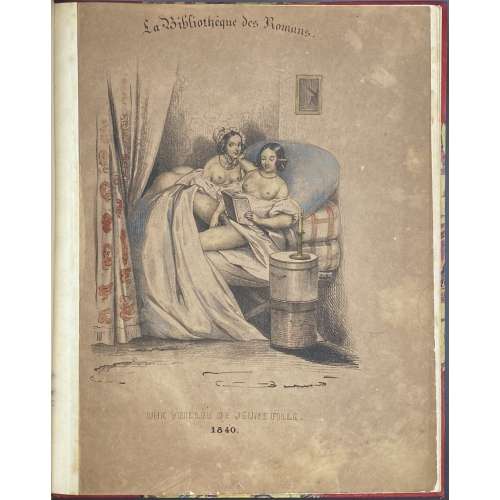 Description: Pictorial album 29.7 x 24 cm, bound in ¾ red morocco over marbled boards with gilt lettering “LA BIBLIOTHÈQUE DES ROMANS” and raised bands to spine; marbled endpapers, two flyleaves, tan original wrapper lettered “La Bibliothèque des Romans. (gothic, arch) | {colour vignette} | UNE VEILLÉE DE JEUNE FILLE. | 1840. || Six hand-coloured lithographs, each in a double-rule border with the series title above it and image title below. Sequential numbers are hand-inscribed within the border in the upper-right corner. Frame 23.5 x 18.3 cm, image 21.5 x 16.5 cm. Three flyleaves at the end. A bookplate to front pastedown: “GERARD NORDMANN EX-LIBRIS”. Content:
Description: Pictorial album 29.7 x 24 cm, bound in ¾ red morocco over marbled boards with gilt lettering “LA BIBLIOTHÈQUE DES ROMANS” and raised bands to spine; marbled endpapers, two flyleaves, tan original wrapper lettered “La Bibliothèque des Romans. (gothic, arch) | {colour vignette} | UNE VEILLÉE DE JEUNE FILLE. | 1840. || Six hand-coloured lithographs, each in a double-rule border with the series title above it and image title below. Sequential numbers are hand-inscribed within the border in the upper-right corner. Frame 23.5 x 18.3 cm, image 21.5 x 16.5 cm. Three flyleaves at the end. A bookplate to front pastedown: “GERARD NORDMANN EX-LIBRIS”. Content:- Front wrapper (title-page)
- SŒUR ANNE (Sister Anne)
- LA GRISETTE (The grisette)
- LÉONIDE OU LA VIEILLE DE SURÊNE (Léonide or the old lady of Surêne)
- LA PUCELLE DE BELLEVILLE (The maid of Belleville)
- MON VOISIN RAYMOND (My neighbor Raymond)
- LE COCU (The cuckold)
-
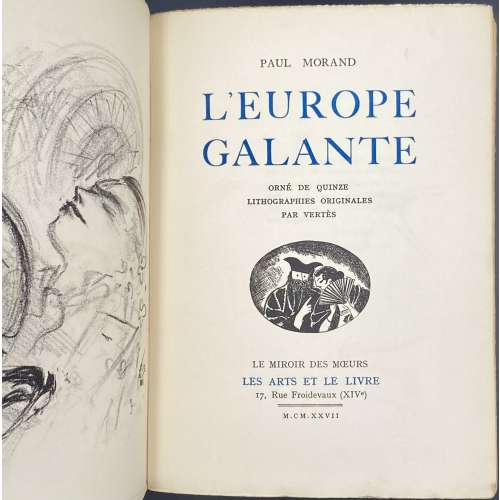 Front wrapper (in black and blue): PAUL MORAND | L'EUROPE | GALANTE | QUINZE LITHOGRAPHES | HORS TEXTE ORIGINALES | DE VERTÈS | {vignette} | LE MIROIR DES MŒURS | LES ARTS ET LE LIVRE | =| M. CM. XXVII || Title-page (in black and blue): PAUL MORAND | L'EUROPE | GALANTE | ORNÉ DE QUINZE | LITHOGRAPHES ORIGINALES | PAR VERTÈS | {vignette} | LE MIROIR DES MŒURS | LES ARTS ET LE LIVRE | 17 Rue Froidevaux (XIVe) | =| M. CM. XXVII || Pagination: [1-9] 10-245 [7], and 2 leaves under the wrappers, ils. Collation: 8vo; [1]8 2-168; first and last leaves under wrappers; total 128 leaves and 17 plates extraneous to collation (two more than the declared 15). Binding: 20.5 x 14.5, French flapped tan wrappers with lettering and vignette, lettering to spine. Printed on May 30, 1927 at l'Imprimerie du Livre, Rueil (Henri Filipacchi, director); under supervision of Georges-Célestin Crès. Edition: 3rd book is the series "Le miroir des mœurs", limited to 1165 copies of which 65 on Papier d'Annam, 15 of them not for sale, numbered 1-50 and 51-65, respectively; 1100 copies on Vélin teinté de Rives (100 of them not for sale), numbered 66-1065 and 1066-1165, respectively. This copy is № 474. Contributors: Paul Morand (French, 1888 – 1976) – author. Marcel Vertès [Marcell Vértes] (Jewish-Hungarian-French, 1895 – 1961) – artist. Les arts et le livre; Georges-Célestin Crès (French, 1875 – 1935) – publisher. l'Imprimerie du Livre (Rueil); Henri Élie Michel Filipacchi [Flippaki] (French, 1900 – 1961) – printer. Other names: Marcel Vertès, Marcel Vertes, Marcell Vértes
Front wrapper (in black and blue): PAUL MORAND | L'EUROPE | GALANTE | QUINZE LITHOGRAPHES | HORS TEXTE ORIGINALES | DE VERTÈS | {vignette} | LE MIROIR DES MŒURS | LES ARTS ET LE LIVRE | =| M. CM. XXVII || Title-page (in black and blue): PAUL MORAND | L'EUROPE | GALANTE | ORNÉ DE QUINZE | LITHOGRAPHES ORIGINALES | PAR VERTÈS | {vignette} | LE MIROIR DES MŒURS | LES ARTS ET LE LIVRE | 17 Rue Froidevaux (XIVe) | =| M. CM. XXVII || Pagination: [1-9] 10-245 [7], and 2 leaves under the wrappers, ils. Collation: 8vo; [1]8 2-168; first and last leaves under wrappers; total 128 leaves and 17 plates extraneous to collation (two more than the declared 15). Binding: 20.5 x 14.5, French flapped tan wrappers with lettering and vignette, lettering to spine. Printed on May 30, 1927 at l'Imprimerie du Livre, Rueil (Henri Filipacchi, director); under supervision of Georges-Célestin Crès. Edition: 3rd book is the series "Le miroir des mœurs", limited to 1165 copies of which 65 on Papier d'Annam, 15 of them not for sale, numbered 1-50 and 51-65, respectively; 1100 copies on Vélin teinté de Rives (100 of them not for sale), numbered 66-1065 and 1066-1165, respectively. This copy is № 474. Contributors: Paul Morand (French, 1888 – 1976) – author. Marcel Vertès [Marcell Vértes] (Jewish-Hungarian-French, 1895 – 1961) – artist. Les arts et le livre; Georges-Célestin Crès (French, 1875 – 1935) – publisher. l'Imprimerie du Livre (Rueil); Henri Élie Michel Filipacchi [Flippaki] (French, 1900 – 1961) – printer. Other names: Marcel Vertès, Marcel Vertes, Marcell Vértes -
 Colour (tone) lithography, image 396 x 508 mm, sheet 532 x 654 mm; before signature, undated; pencil ms inscription: Föhrenhain — E. Pelikan / 200M to the lower-right corner of the sheet. Contributor: Emilie Mediz-Pelikan (Austrian, 1861 – 1908) – artist. Seller's description: Austrian-German painter and graphic artist. Emilie Mediz-Pelikan was born in Vöcklabruck in 1861. She studied at the Vienna Academy and followed her teacher Albert Zimmermann to Salzburg and in 1885 to Munich. In 1891 she married the painter and graphic artist Karl Mediz (1868 - 1945), with whom she lived in Vienna and from 1894 in Dresden. She was in contact with the Dachau Artists' Colony and went on study trips to Paris, Belgium, Hungary and Italy. In the Dachau artists' colony she was friends with Adolf Hölzel and Fritz von Uhde. In 1889 and 1890 she spent time in Paris and in the Belgian artists' colony Knokke. In 1898 she was represented at the first art exhibition of the Vienna Secession, and in 1901 at the International Art Exhibition in Dresden. In 1903 she and her husband had a group exhibition, at the Hagenbund in Vienna. In 1904, she showed graphic works at the Dresden royal court art dealer Richter, and in 1905 and 1906 she exhibited at the Berlin Künstlerhaus. It was not until around 1900 that she achieved her artistic breakthrough with her landscape paintings. Since the estate of the artist, who died prematurely in Dresden in 1908, was lost in the former GDR until the 1980s, it was quite late that the artist was rediscovered and revalued both in Austrian art history and on the art market. In 1986, the first major exhibitions took place at the Upper Austrian State Museum and the University of Applied Arts in Vienna, followed by numerous smaller exhibitions in private galleries in Vienna, Linz and Munich. The artist received recognition during her lifetime from numerous prominent fellow painters as well as from the art critic Ludwig Hevesi. Together with Tina Blau, Herbert Boeckl, Marie Egner, Theodor von Hörmann, Franz Jaschke, Eugen Jettel, Ludwig Heinrich Jungnickel, Rudolf Junk, Gustav Klimt, Oskar Kokoschka, Johann Victor Krämer, Heinrich Kühn, Carl Moll, Rudolf Quittner, Rudolf Ribarz, Emil Jakob Schindler, Max Suppantschitsch, Max Weiler, Olga Wisinger-Florian and Alfred Zoff, she was a protagonist of the reception of Impressionism in Austria. This style went down in Austrian art history under the term "Stimmungsimpressionismus".
Colour (tone) lithography, image 396 x 508 mm, sheet 532 x 654 mm; before signature, undated; pencil ms inscription: Föhrenhain — E. Pelikan / 200M to the lower-right corner of the sheet. Contributor: Emilie Mediz-Pelikan (Austrian, 1861 – 1908) – artist. Seller's description: Austrian-German painter and graphic artist. Emilie Mediz-Pelikan was born in Vöcklabruck in 1861. She studied at the Vienna Academy and followed her teacher Albert Zimmermann to Salzburg and in 1885 to Munich. In 1891 she married the painter and graphic artist Karl Mediz (1868 - 1945), with whom she lived in Vienna and from 1894 in Dresden. She was in contact with the Dachau Artists' Colony and went on study trips to Paris, Belgium, Hungary and Italy. In the Dachau artists' colony she was friends with Adolf Hölzel and Fritz von Uhde. In 1889 and 1890 she spent time in Paris and in the Belgian artists' colony Knokke. In 1898 she was represented at the first art exhibition of the Vienna Secession, and in 1901 at the International Art Exhibition in Dresden. In 1903 she and her husband had a group exhibition, at the Hagenbund in Vienna. In 1904, she showed graphic works at the Dresden royal court art dealer Richter, and in 1905 and 1906 she exhibited at the Berlin Künstlerhaus. It was not until around 1900 that she achieved her artistic breakthrough with her landscape paintings. Since the estate of the artist, who died prematurely in Dresden in 1908, was lost in the former GDR until the 1980s, it was quite late that the artist was rediscovered and revalued both in Austrian art history and on the art market. In 1986, the first major exhibitions took place at the Upper Austrian State Museum and the University of Applied Arts in Vienna, followed by numerous smaller exhibitions in private galleries in Vienna, Linz and Munich. The artist received recognition during her lifetime from numerous prominent fellow painters as well as from the art critic Ludwig Hevesi. Together with Tina Blau, Herbert Boeckl, Marie Egner, Theodor von Hörmann, Franz Jaschke, Eugen Jettel, Ludwig Heinrich Jungnickel, Rudolf Junk, Gustav Klimt, Oskar Kokoschka, Johann Victor Krämer, Heinrich Kühn, Carl Moll, Rudolf Quittner, Rudolf Ribarz, Emil Jakob Schindler, Max Suppantschitsch, Max Weiler, Olga Wisinger-Florian and Alfred Zoff, she was a protagonist of the reception of Impressionism in Austria. This style went down in Austrian art history under the term "Stimmungsimpressionismus". -
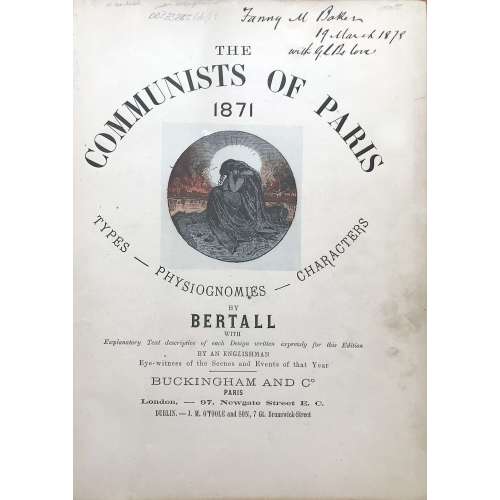 Folio (246 x 321 mm), hardbound in red-brown cloth with gilt lettering and decoration. Content, Introduction by J. E., September, 1873, Artist preface by Bertall, Paris, 1871-1873. Album with 40 hand-colored lithographs by Bertall, numbered 1 through 40, accompanied with extensive descriptions. Ex Libris: Baker. Carpe Diem. Markings: Janny M. Baker with J.L.B. Love, 19 March, 1878 in black ink.
Folio (246 x 321 mm), hardbound in red-brown cloth with gilt lettering and decoration. Content, Introduction by J. E., September, 1873, Artist preface by Bertall, Paris, 1871-1873. Album with 40 hand-colored lithographs by Bertall, numbered 1 through 40, accompanied with extensive descriptions. Ex Libris: Baker. Carpe Diem. Markings: Janny M. Baker with J.L.B. Love, 19 March, 1878 in black ink. -
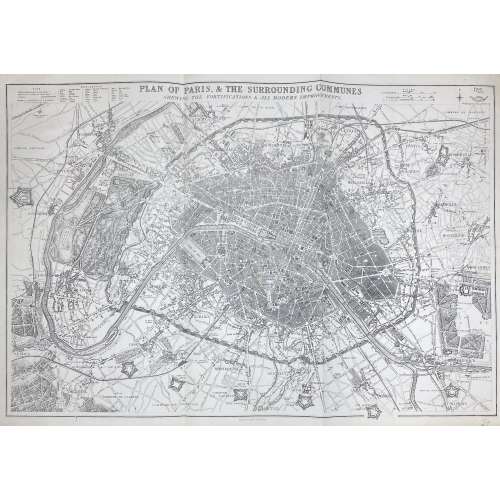 PLAN OF PARIS & THE SURROUNDING COMMUNES | SHEWING THE FORTIFICATIONS & ALL MODERN IMPROVEMENTS. || Lettered above the image with title, and below with production detail: "Day & Son, Lithrs to the Queen"; and production detail above: "Drawn & Engraved by B.R. Davies: / 16 George Str Euston Squ London", and on top right: "Weekly Dispatch Atlas, 138 Fleet Str". Dimensions: 47.5 x 65.4 cm. Contributors: Day & Son; William Day (British, 1797 – 1845) – lithographer, printer. Davies, Benjamin Rees (British, 1789 – 1872) – artist, engraver.
PLAN OF PARIS & THE SURROUNDING COMMUNES | SHEWING THE FORTIFICATIONS & ALL MODERN IMPROVEMENTS. || Lettered above the image with title, and below with production detail: "Day & Son, Lithrs to the Queen"; and production detail above: "Drawn & Engraved by B.R. Davies: / 16 George Str Euston Squ London", and on top right: "Weekly Dispatch Atlas, 138 Fleet Str". Dimensions: 47.5 x 65.4 cm. Contributors: Day & Son; William Day (British, 1797 – 1845) – lithographer, printer. Davies, Benjamin Rees (British, 1789 – 1872) – artist, engraver.


